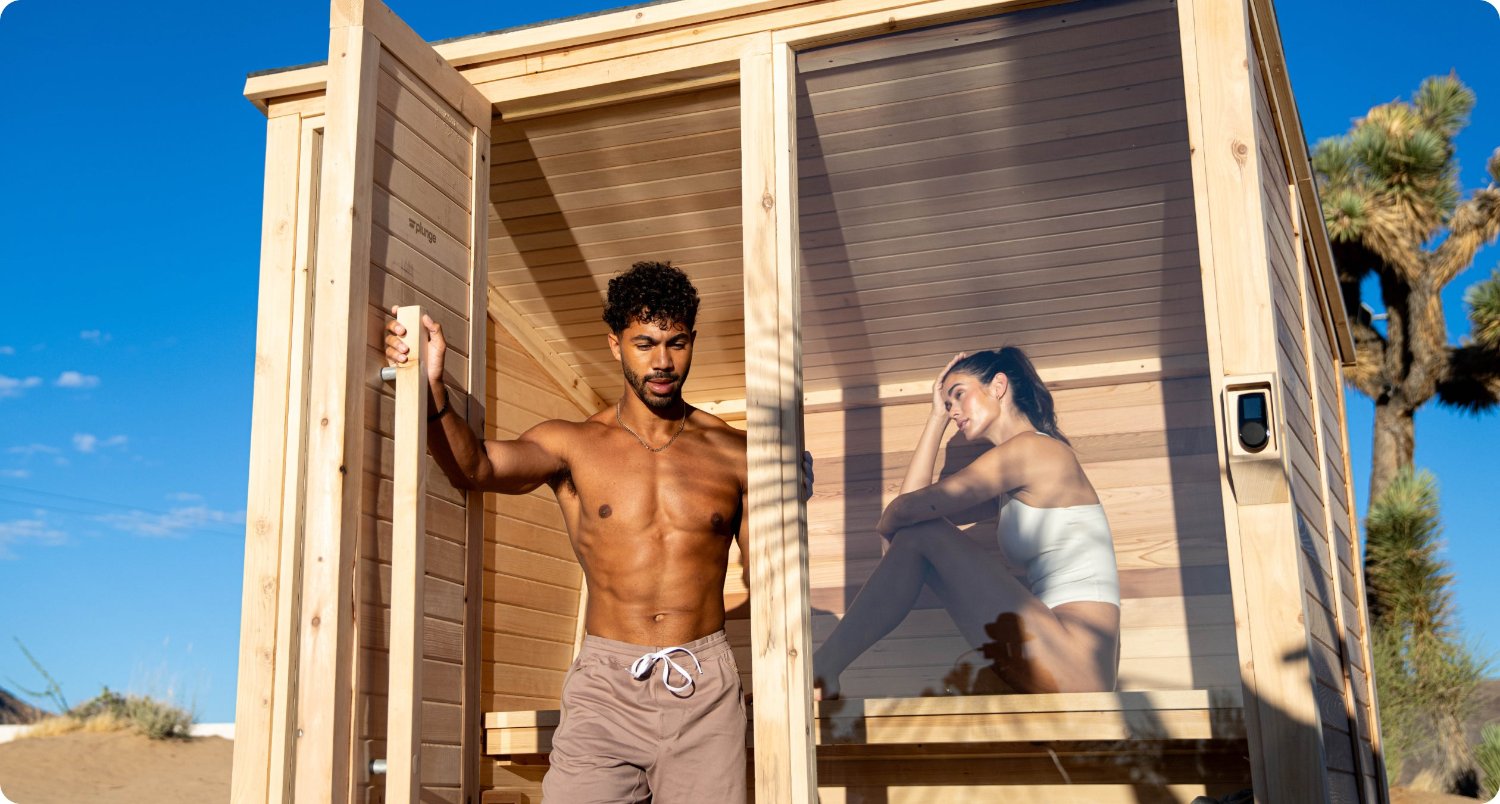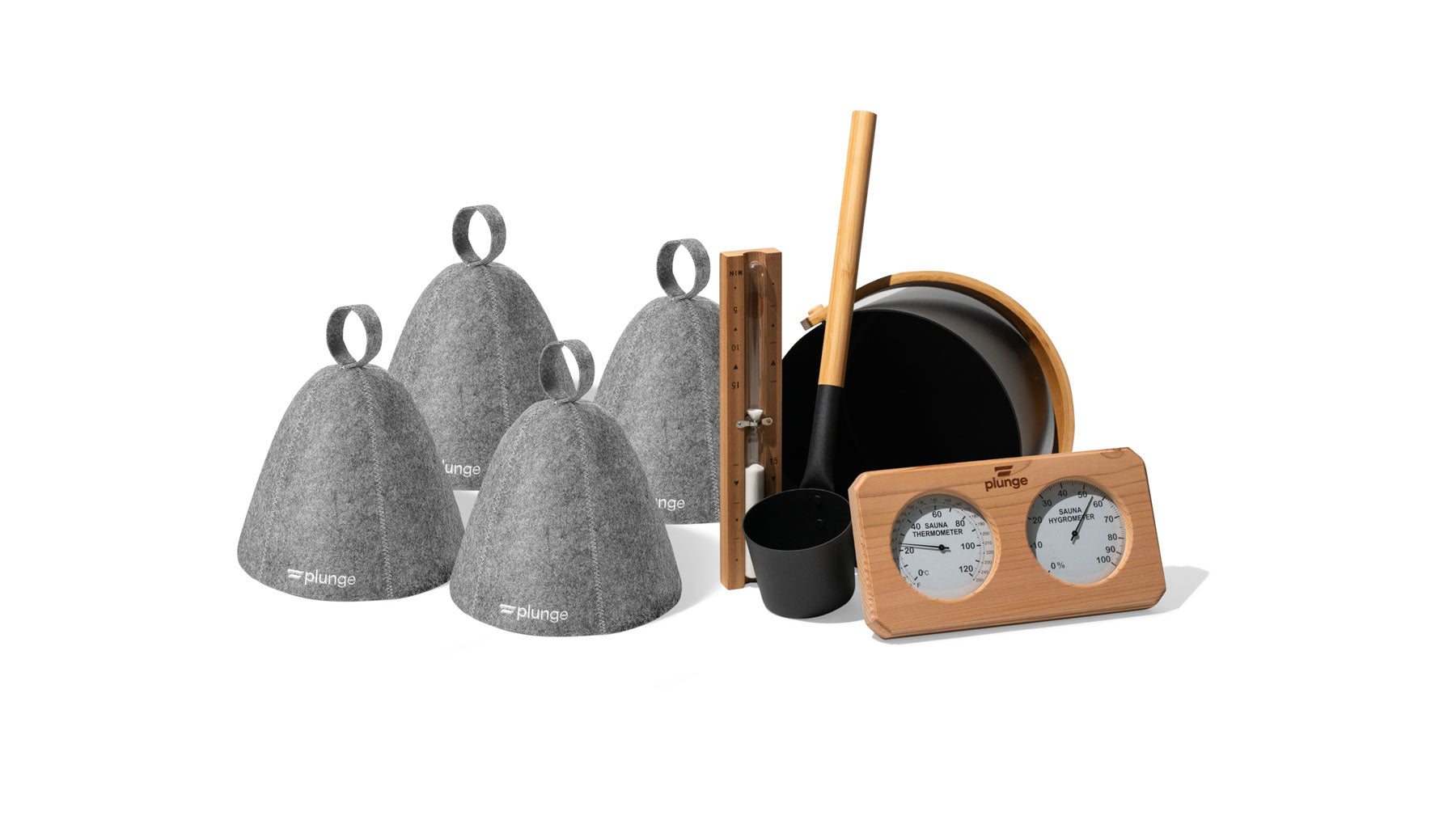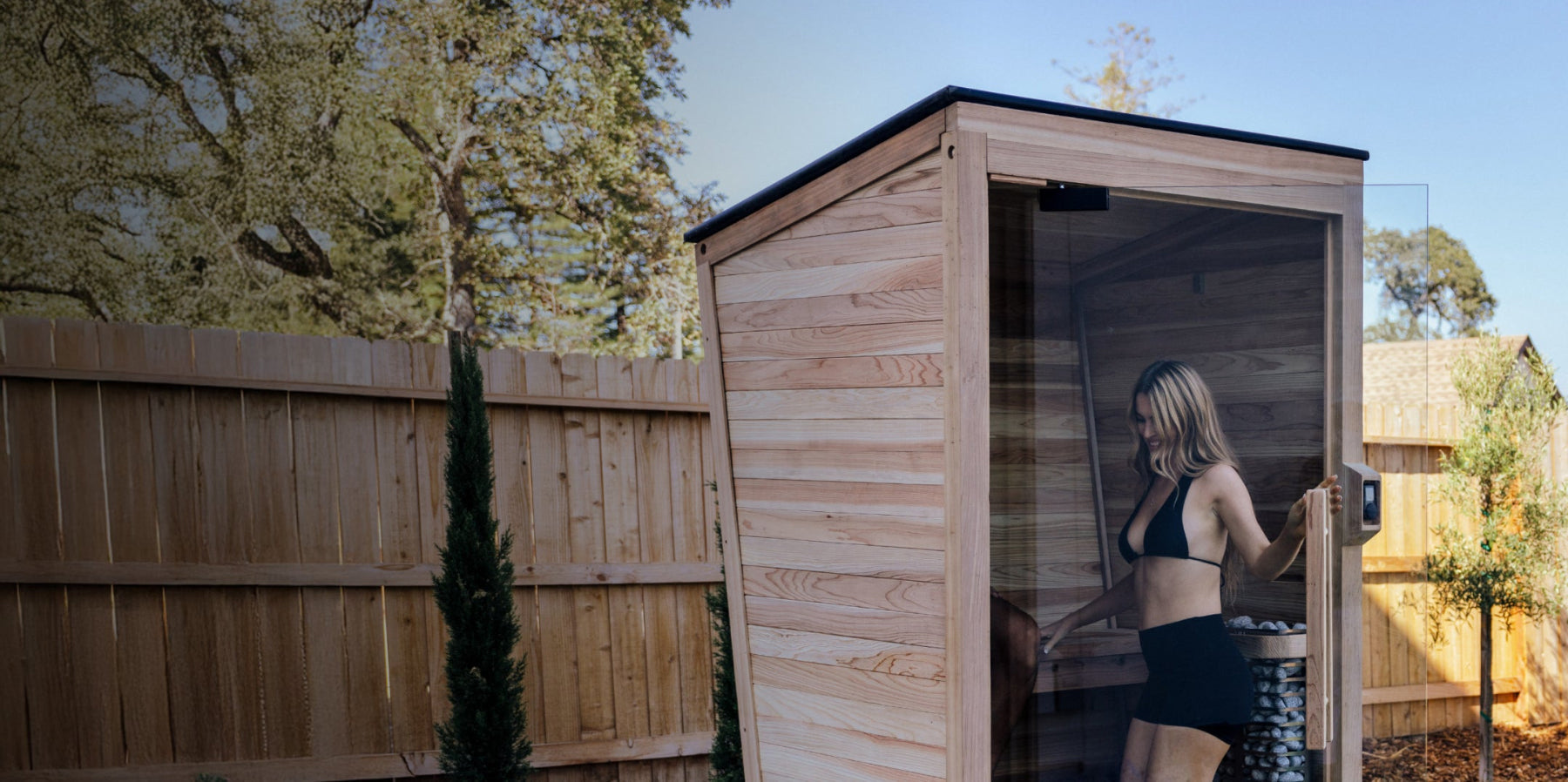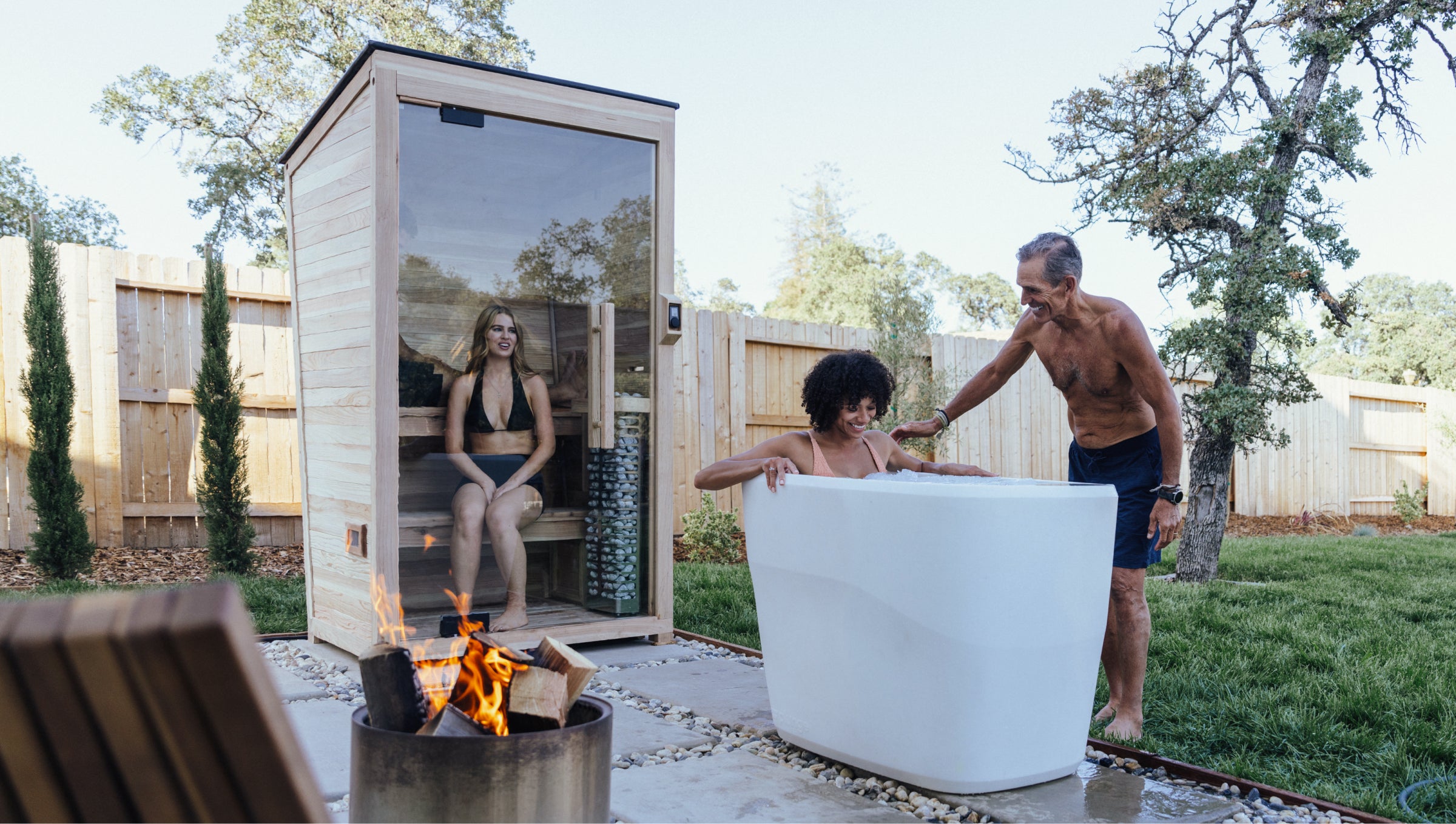
Beginner's Guide: How to Set Up & Use a Sauna
Though sauna bathing has existed for thousands of years, heat therapy has never been more popular than it is today. It’s easy to see why: a regular sauna routine can detoxify your body, encourage muscle recovery, improve sleep, reduce stress, and improve your cardiovascular health.
A traditional sauna is simply a small cabin heated by a wood-burning stove. Today, there are many types of saunas: wood-burning, gas-powered, and electric. High-tech infrared saunas are another great option for people who prefer less intense heat.
In this guide, you’ll learn everything you need to know about how to use a dry sauna, including how to set a sauna up, what to expect in an infrared sauna and in a traditional sauna, and how to get the most out of your first sweat.
How to Use a Sauna
Using the sauna is just one part of a ritual that can ease you into a state of deep relaxation.
First, it’s important to plan your sauna sessions around your other daily routines. If you’ve recently eaten a big meal, wait at least an hour before entering the sauna. Similarly, don’t begin a sauna session until at least half an hour after exercising.
When you’re ready to unwind, turn the sauna on. Most modern saunas have heaters that can be operated from a control panel or mobile app; older saunas may require you to light a stove.
Choose your desired temperature and allow the sauna to “cure,” or preheat, for half an hour while you take a shower. A quick rinse will clean and open your pores, which can give you a better sweat and prevent unwanted odors in the sauna cabin.
When you enter and leave the sauna, open and shut the door as quickly as possible to avoid letting the heat out. Once inside, start your session by sitting on the bottom bench. If space allows, try lying down to spread the heat more evenly over your body. For more heat, you can move to the top bench, or you can pour water over the sauna’s rocks to create steam.
After your sweat, leave the door open to allow the cabin to cool and air out. Brush all the sauna’s surfaces down with plain water to keep the sauna clean and hygienic.
Saunas are safe and healthy for most people, but heat therapy is not for everyone. If you are currently ill, pregnant, or intoxicated, it’s best to forgo the sauna. If you have heart or blood pressure issues, talk to your doctor before trying sauna bathing.
Setting Up Your At-Home Sauna
Before you purchase a home sauna, determine where you’d like to place it. The Plunge Sauna or Sauna XL can go inside your garage gym or outside in your backyard. Either way, the space you choose for your sauna should be a flat and level, well-ventilated, far from water, and close to a location where an electrician can install an outlet.
Before your Plunge Sauna arrives, hire a licensed electrician to install a dedicated outlet, if needed, depending on the sauna’s electrical requirements. Be sure to purchase a power cord that is long enough to run between the sauna and the outlet.
When your sauna arrives, set aside 2-4 hours to assemble it. Construction is a two-person job, but because the Plunge Sauna is modular, it is simple to construct using the instructions in the Plunge Sauna manual. Your sauna purchase includes a Huum heater, approximately 100 pounds of stones, a WiFi controller, and a phone mount: everything you need to get started.
Once your sauna is fully constructed, use the instructions in the manual to sync the sauna’s control panel with your WiFi. This will allow you to operate the Sauna from the Plunge mobile app.
You may want to add lighting, music, or other accessories to make your sauna more inviting. You may even choose to decorate the outside of your sauna to match your decor. Just be sure that whatever you bring into the sauna can be operated safely in a high-heat and humid environment.
What to Expect in an Infrared Sauna
Infrared saunas use long-wavelength light rays to penetrate your skin, warming your body without heating the air around you. Infrared saunas can provide many of the health benefits of traditional saunas without the intense heat.
While a traditional sauna can reach temperatures of over 200° F, an infrared sauna heats up to only 100-140° F. This makes it a great sauna for beginners or for people who cannot tolerate high heat.
Because the heat in an infrared sauna is lower, you may need to use it for longer than you’d use a traditional sauna to fully feel its effects. While you should limit your sweats to 20 minutes in a traditional sauna, a 30-40 minute sweat might be more effective in an infrared sauna.
Despite its gentler feel, an infrared sauna will still make you sweat. You may leave the infrared sauna feeling energized, or you may be a bit drowsy after your session. All the safety precautions for using a traditional sauna apply to using an infrared sauna, too. Stay hydrated and take time to cool down afterward.
Sauna Tips for Beginners
1. Remember to Stay Hydrated Before, During, and After
Sweating can quickly lead to dehydration. Because the air in a sauna can become very dry, you may not even realize how much liquid you’re losing. Drink water before, during, and after your sauna session: a quart is a good goal.
If you aren’t in the mood for water, unsweetened tea, coconut water or an electrolyte drink are other good options. Avoid diuretics like soda or carbonated drinks, and whatever you do, don’t drink alcohol before, during, or immediately after a stint in the sauna.
2. Get the Right Sauna Temperature for Beginners
For your first time in the sauna, it’s best to heat the cabin to around 150-175° F. If you can tolerate that temperature without discomfort, try increasing the heat 5-10° F at a time until you are satisfied with your sweat.
The most important thing is to listen to your body. If you ever become faint, dizzy, nauseous, or extremely thirsty in the sauna, turn the temperature down or end your session.
3. How to Decide What to Wear
Your attire in the sauna should be determined by comfort. Many sauna aficionados believe that sauna bathing naked is best, but if being nude is uncomfortable for you, try a bathing suit or loose-fitting, breathable attire, like a t-shirt and shorts or a cotton sundress.
Don’t wear closed-toed shoes in the sauna. If you must cover your feet, try sandals or shower shoes. Avoid wearing jewelry in the sauna to avoid damaging it in the heat.
Finally, always bring a towel to sit or lie on in the sauna. A towel will also allow you to wipe sweat out of your eyes.
4. Start with Shorter Sessions
Before you know how the sauna will affect your body, start with short sweats: ten minutes is a great place to start. Over time, you might begin to prefer longer sweats, but it’s best not to exceed 20 minutes per session.
Many people like to enter and exit the sauna 2-3 times per session, cooling off outside between sweats. For an added boost, try contrast therapy by cooling down in a cold plunge between sauna sessions. Alternating between the intense heat of the sauna and the cold of the plunge can enhance circulation, reduce inflammation, and promote muscle recovery. This is a great way to maximize the health benefits of saunas without overtaxing your body. As always, discontinue your sauna session and cool off if you’re feeling unwell.
5. Try Dry Brushing to Improve Circulation
Exfoliation can prepare you for the sauna by opening your pores and improving lymph and blood flow. Today, many sauna users incorporate exfoliation into their sauna routine by dry brushing.
After taking your pre-sauna shower and toweling dry, use a body brush to brush dead skin cells from your legs, arms, and torso. Start from your feet and work upward, using light pressure on areas where your skin is thin and firmer pressure where it is thick.
6. How Often Should Beginners Use a Sauna
Just as you should slowly ease into longer and hotter sauna sessions, you should ease into a weekly sauna routine. To start, try using the sauna 2-3 times per week. If your body adjusts well to that routine, then you can gradually work up to a daily or alternate-day schedule to maximize the benefits of sauna bathing.
7. Post-Session Cool Down (and What Else To Do After Saunas)
Traditionally, Scandinavians jump into a cold lake or roll around in the snow to lower their body temperatures after a sweat. However, if you are a sauna novice, it’s best to cool down slowly to help your body gently return to baseline. Try rinsing off under a cool shower or simply sitting outside in the cold air
Once you are used to sauna bathing, you might try a more extreme cool-down in a cold plunge tub. Alternating between heat and cold, or contrast therapy, can release endorphins, improve the body’s circulation, and boost immune function.
Once you’ve cooled down, it’s time to chill. Stretching and meditation are great ways to wind down. A light, healthy snack can replenish vitamins, minerals, and electrolytes that you may have lost to sweating. Finally, don’t forget to drink plenty of water.
8. Maintenance and Cleaning Your At-Home Sauna
High-quality traditional saunas are often made of cedar wood, which is naturally antibacterial and antifungal. Still, it’s important to properly maintain your sauna between sweats to keep it clean and functional for years to come.
Everyone who uses the sauna should shower and clean their feet before entering and sit on a towel while inside. After each sauna session, be sure to open the door to allow the sauna to air out. Use a hand brush to scrub the sauna down with water. When it is completely cool, wipe dust and dirt from the heater with a moist cloth.
Every few months, inspect your sauna’s heater and electrical components for damage. If you notice something unusual, contact an electrician for an inspection.
Harness the Power of Heat with a Plunge Sauna
Whether you are interested in the traditional dry sauna experience or curious about taking the infrared route, there’s never been a better time to try heat therapy. Once you establish a sauna routine, you’ll wonder how you ever got by without one.
The Plunge Sauna gives you the best of both worlds: durable, old-world construction and state-of-the-art technology. Construction and set-up are a breeze. Control the heat right from our app. Best of all, Plunge products are FSA/HSA eligible, and financing is available.
Whatever life brings your way, don’t sweat it: you’re just one sauna session away from a healthier, happier you!
























